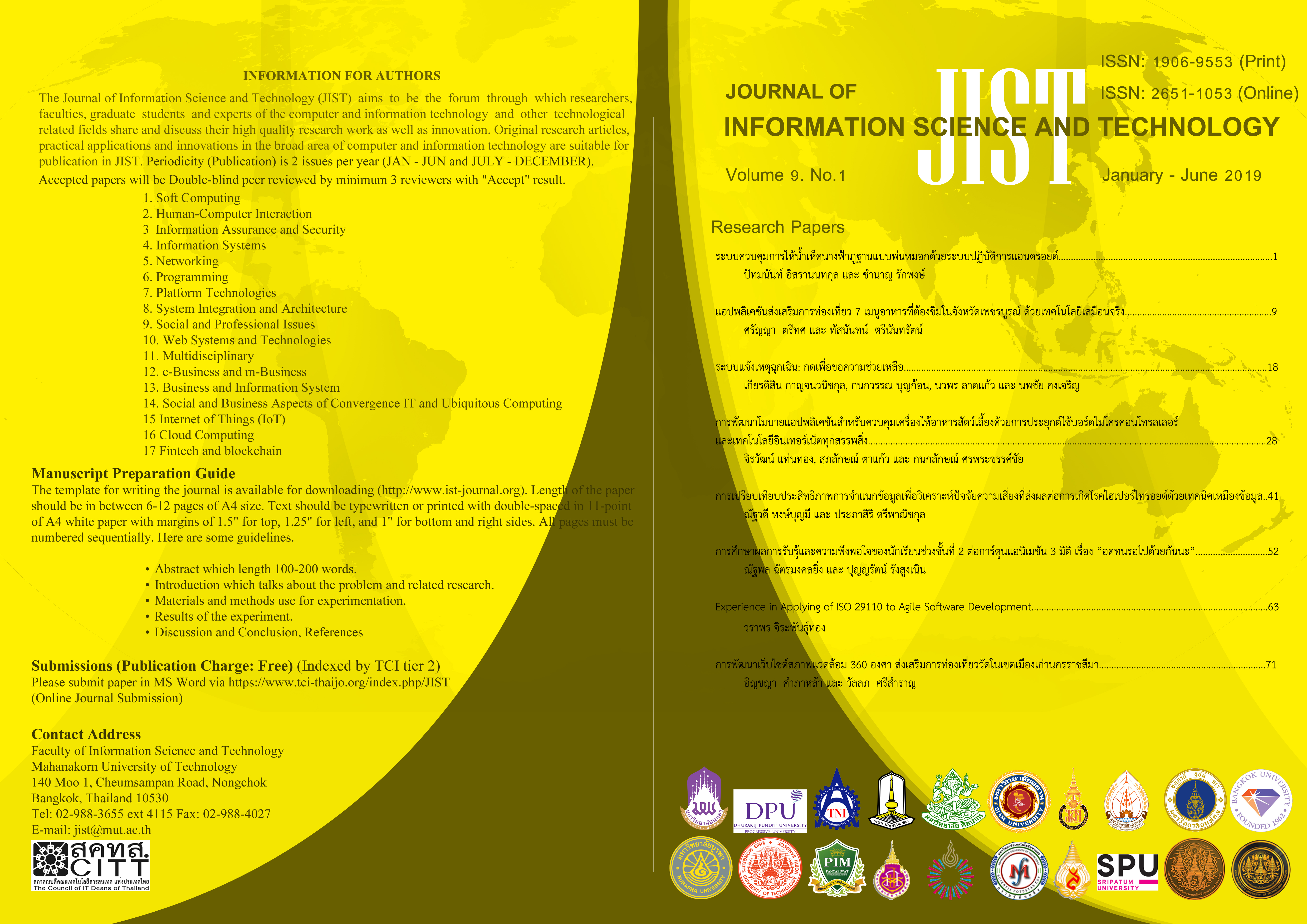The Study of Perception and Satisfaction of Senior Primary School per 3D Animation Cartoon “Be Patient”
Main Article Content
Abstract
The aim of this research is to 1) Development of 3D animation cartoon “Be patient”. 2) Study the perception of the samples after watching 3D animation cartoon. 3) Survey the satisfaction of the sample after watching 3D animation cartoon. The sample consisted of 95 students from the sample using the probability sampling method (Cluster sampling) in the senior primary school, the first semester of academic year 2017, Anuban Nakhonratchasima School. The 3D animation cartoon has developed based on principles of media production include 1) Pre-production 2) Production 3) Post-production (3P). The research found that 1) Quality of 3D animation cartoon overall at the average was 4.38, quality is good. 2) Perception of the sample from watching 3D animation cartoon overall of perception was 83.80 percent, the perception at the highest level. 3) Satisfaction of the sample from watching 3D animation cartoon overall satisfied at the average was 4.72, satisfaction was at a highest level.
Article Details
This work is licensed under a Creative Commons Attribution-NonCommercial-NoDerivatives 4.0 International License.
I/we certify that I/we have participated sufficiently in the intellectual content, conception and design of this work or the analysis and interpretation of the data (when applicable), as well as the writing of the manuscript, to take public responsibility for it and have agreed to have my/our name listed as a contributor. I/we believe the manuscript represents valid work. Neither this manuscript nor one with substantially similar content under my/our authorship has been published or is being considered for publication elsewhere, except as described in the covering letter. I/we certify that all the data collected during the study is presented in this manuscript and no data from the study has been or will be published separately. I/we attest that, if requested by the editors, I/we will provide the data/information or will cooperate fully in obtaining and providing the data/information on which the manuscript is based, for examination by the editors or their assignees. Financial interests, direct or indirect, that exist or may be perceived to exist for individual contributors in connection with the content of this paper have been disclosed in the cover letter. Sources of outside support of the project are named in the cover letter.
I/We hereby transfer(s), assign(s), or otherwise convey(s) all copyright ownership, including any and all rights incidental thereto, exclusively to the Journal, in the event that such work is published by the Journal. The Journal shall own the work, including 1) copyright; 2) the right to grant permission to republish the article in whole or in part, with or without fee; 3) the right to produce preprints or reprints and translate into languages other than English for sale or free distribution; and 4) the right to republish the work in a collection of articles in any other mechanical or electronic format.
We give the rights to the corresponding author to make necessary changes as per the request of the journal, do the rest of the correspondence on our behalf and he/she will act as the guarantor for the manuscript on our behalf.
All persons who have made substantial contributions to the work reported in the manuscript, but who are not contributors, are named in the Acknowledgment and have given me/us their written permission to be named. If I/we do not include an Acknowledgment that means I/we have not received substantial contributions from non-contributors and no contributor has been omitted.
References
2. Amarinbabyandkids. ( 10 เมษายน 2560). “เลี้ยงลูกให้อดทน-แกร่ง-อึด สร้างสุดยอดเด็กเก่งในยุคดิจิทัล,”[Online]. Available:https://www.amarinbabyandkids.com/parenting/toddler/teach-toddler/raise-super-gen-alpha-kids/3.
3. ไทยรัฐออนไลน์. (10 เมษายน 2560). “สำรวจพบเด็กไทย'ขยันน้อย-อดทนต่ำ' เร่งปลูกฝังคุณธรรม,” [Online]. Available: https://www.thairath.co.th/content/414345.
4. กฤษมันต์ วัฒนาณรงค์. (10 เมษายน 2560). “การสอนให้มีความอดทนรอคอย (Delayed Gratification),” [Online]. Available: https://www.thairath.co.th/content/318249.
5. ชนาพร เคลือบคล้าย. (2557). “สพฐ.รับลูกคสช.สร้างค่านิยมคนไทยใหม่,” [Online]. Available:https://www.Moe.go.th/moe/th/news/detail.php?NewsID=37710&Key=hotnews.
6. นิพนธ์ คุณารักษ์, “การวิเคราะห์และวิจารณ์ภาพยนตร์แอนิเมชัน,” วารสารศูนย์บริการวิชาการ, ปีที่ 16, ฉบับที่ 4, หน้า 42-46, ตุลาคม-ธันวาคม, 2551.
7. ดวงเนตร คงปรีพันธุ์, “การเปรียบเทียบผลสัมฤทธิ์ทางการเรียนและความคงทนในการจำเนื้อหา ที่เป็นกระบวนการของนักเรียนที่มีความบกพร่องทางการได้ยินที่เรียนด้วยบทเรียน คอมพิวเตอร์ช่วยสอน ที่มีกลยุทธ์การนำเสนอภาพเคลื่อนไหวต่างกัน,” วิทยานิพนธ์ปริญญาครุศาสตรมหาบัณฑิต, จุฬาลงกรณ์มหาวิทยาลัย, กรุงเทพฯ, 2541.
8. สรชัย ชวรางกูร, “การศึกษาเปรียบเทียบผลสัมฤทธิ์ทางการเรียนและความสนใจของนักเรียนช่วงชั้นที่ 2 ที่มีต่อการ์ตูนแอนิเมชันรูปแบบ 2 มิติ และ 3 มิติ,”วิทยานิพนธ์ หลักสูตรครุศาสตร์อุตสาหกรรมมหาบัณฑิต สาขาวิชาเทคโนโลยีคอมพิวเตอร์ ภาควิชาคอมพิวเตอร์ศึกษา, บัณฑิตวิทยาลัย สถาบันเทคโนโลยีพระจอมเกล้าพระนคร, กรุงเทพฯ, 2550.
9. Xia San-ao, “Application of Maya in film 3D animationdesign,” HuNan University of science and engineering, Yongzhou 425006, China, 2011.
10. ชุติพงศ์ พันธุ์สมบัติ, “การพัฒนาการ์ตูนแอนิเมชัน 3 มิติโดยใช้เทคนิคการนำเสนอแบบเล่านิทานเป็นฐาน เรื่องการบริโภคอาหาร สำหรับเด็กปฐมวัย,” วิทยานิพนธ์ หลักสูตรปริญญาวิทยาศาสตร์มหาบัณฑิต สาขาวิชาสื่อนฤมิต, มหาวิทยาลัยมหาสารคาม, จังหวัดมหาสารคาม, 2556.
11. อชิตา เทพสถิต, “การออกแบบแอนิเมชัน 3 มิติ การกินอย่างถูกหลักโภชนาการ,” วิทยานิพนธ์หลักสูตรศิลปมหาบัณฑิต สาขาวิชาคอมพิวเตอร์อาร์ต คณะดิจิทัลอาร์ต, มหาวิทยาลัยรังสิต, กรุงเทพฯ, 2557.
12. วงเดือน พลอยงาม และ ศุภพักตร์ จารุเศรณี, “สื่อโฆษณาแผ่นพับเสมือน 3 มิติ ผ่านทางสมาร์ทโฟน สำหรับจัดแสดงในนิทรรศการท่องเที่ยว”, วารสารวิทยาการและเทคโนโลยีสารสนเทศ, ปีที่ 8, ฉบับที่ 2, หน้า 37-45, กรกฎาคม-ธันวาคม, 2561.



